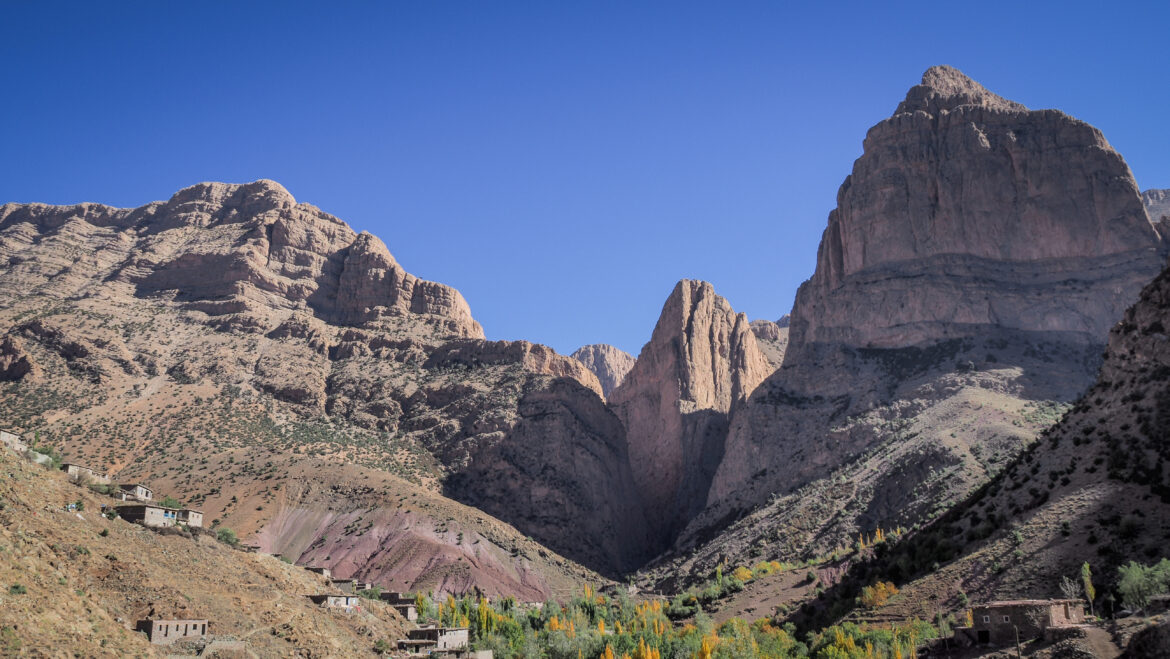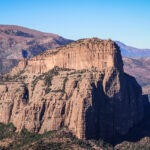Zaouiat Ahansal is a small, remote village in Morocco’s High Atlas Mountains. It gets its name from the local “zaouia” (religious school or monastery) founded by Sidi Said Ahansal, a revered Islamic scholar and saint.
The village’s religious roots date back to the 16th century when it became a spiritual hub for the surrounding Berber tribes. Sidi Said Ahansal, the founder of the zaouia, established a religious order that drew followers from the High Atlas region. The influence of the Ahansal family extended over centuries, and the local zaouia was both a centre of learning and a point of unity for the local Amazigh (Berber) communities. Today, the religious significance of the village remains a key part of its identity.
Zaouiat Ahansal is set in a dramatic mountainous landscape, surrounded by towering peaks, rugged valleys, and winding rivers, including the Assif Ahansal River. The area is part of Morocco’s central High Atlas range and is known for its pristine nature, making it a popular destination for adventure tourists, climbers, and hikers.
The population of Zaouiat Ahansal is predominantly Amazigh, and the local culture is deeply rooted in traditional Berber customs, language, and ways of life. The Berber people have preserved their unique customs, dialects, and cultural practices for generations in the face of modern challenges. Traditional festivals, clothing, and crafts remain vital parts of everyday life, though they slowly adapt to the contemporary world.


In recent years, Zaouiat Ahansal has become an emerging destination for eco-tourism and adventure travel. Visitors come to explore the untouched natural beauty of the High Atlas, engage in trekking, mountain biking, and rock climbing, or experience the quiet, traditional life of the Amazigh people. Due to its relative isolation, the village has managed to retain much of its authenticity, making it attractive to tourists seeking less commercialized experiences.
When it comes to rock climbing, nearby Taghia Gorge has gained a reputation as one of the premier destinations in the country. The steep limestone walls offer a variety of climbing routes, ranging from technical sport climbs to long, multi-pitch trad routes. Due to the complexity and difficulty of many of the climbs, Taghia attracts serious climbers, including professionals from around the world. The routes vary in difficulty, but many are highly challenging, with climbs often exceeding 300 meters. The gorge is often compared to renowned climbing locations in Europe and has been described as a “paradise” for big-wall climbers. The area was relatively unknown in the global climbing community until the late 20th century when international climbers began exploring the region. The remoteness means that amenities and modern conveniences are limited, adding to the appeal for those looking for an immersive adventure in a natural, undeveloped setting.
How to get there?
Getting to Zaouiat Ahansal, a remote village in the High Atlas Mountains of Morocco, requires some planning due to its isolated location and lack of direct transportation options. However, the journey offers a rewarding experience through Morocco’s rugged mountain landscapes. The most common starting point for travellers heading to Zaouiat Ahansal is Marrakech, the nearest major city with an international airport and well-developed infrastructure. From Marrakech, you have two main options: renting a car or using public transport, though the latter will involve multiple steps.
By Car
Renting a car is the most flexible and efficient way to reach Zaouiat Ahansal, as it gives you control over the journey and allows you to explore the surrounding area at your own pace. The drive from Marrakech takes around 5-7 hours, depending on road conditions and stops.
From Marrakech, head northeast toward the town of Azilal. You’ll follow the R210 road toward Demnate, then take the R304 road, which passes through stunning mountainous terrain. After reaching Azilal, continue toward Ait M’Hamed and head to Zaouiat Ahansal via the rural R302 road. This road becomes narrower and more challenging as you ascend into the High Atlas.
By Public Transport
While public transport options are limited, combining buses and taxis to reach Zaouiat Ahansal is possible, though this will take longer and may require flexibility.
Firstly, take a bus from Marrakech to Azilal. Several bus companies operate this route, and the journey takes about 4-5 hours. Buses to Azilal leave from the main bus station in Marrakech (Gare Routière).
Secondly, find a shared taxi from Azilal to Ait M’Hamed. The grand taxis are often crowded and less comfortable than buses but are commonly used for travel in rural Morocco.
From Ait M’Hamed, there may be local taxis or 4×4 vehicles available to take you to Zaouiat Ahansal, though this can depend on demand. Alternatively, you can hire a guide and arrange a multi-day trek from Ait M’Hamed or another nearby village to reach Zaouiat Ahansal, which can be an adventurous option.
The best time to visit
Plan your trip in spring or autumn for the best weather conditions. Winter can bring snow and ice to the higher mountain roads, making them difficult to navigate. Summer can be hot, but temperatures are milder in the mountains.
You should always have some warmer layers, regardless of the season. In the end, it’s mountains there!
How long to stay there?
One day is enough if you just plan to drive to Taghia Gorge and do some hiking there. You should plan some extra time if you are a climbing enthusiast.
Where to stay?
There are some basic guesthouses in Zaouiat Ahansal, and staying with local families is also an option. I spent the night in AUBERGE Kasbah Ouad Ahanssal. The location is magnificent and so are the views around the property. The shower always had hot water and the dinner was delicious.
What to do in Taghia Gorge?
Passage Berbere
A wonderful place to discover but not for people who are quickly affected by dizziness or are afraid of exposition. It is better to start the adventure in the morning if the weather is mild and the path is dry. Good shoes and a warm layer of clothing are a must. Avoid going there solo in case something goes wrong. Taking a guide might be a smart idea. Otherwise, follow the trail which is visible on Mapy.cz, as shown below. The first section is of medium difficulty and involves some easy scrambling. Then, the proper Passage Berbere is something that I didn’t care to cross. It was made with sticks and stones during the colonization of Morocco so that the Moroccan soldiers could escape the enemy army.



Drive from Zaouiat Ahansal to Taghia
The dirt road linking these two villages is very narrow so you may have some problems if there is a car coming from the opposite direction. The distance is about 9 kilometers and the views are simply breathtaking with you being surrounded on both sides by the high walls of rock. In good weather conditions, the road is passable in a standard 2WD car (I did it in a Renault Clio). When I was passing through some village en route, there were quite aggressive kids, wanting money and hitting the car windows with their hands. Moments like this make me sceptic about travelling to Morocco but luckily soon happy feelings take over when I see the landscapes. If that happens to you, just keep the door of the car locked and slowly move forward. Do not give those kids any money!


Canyon Tazart
On the way back from Taghia, look for some small village with a few houses on your left. It’s a good idea to make a stop there and check out Canyon Tazart. Just follow the dried river bed and double-check your position on Mapy.CZ.
The gorge is completely different from the one around Passage Berbere and walking felt was much safer. At some point, as it was getting late, I decided to turn around and return taking the same path. You should definitely avoid this place in case of rainy weather due to the risk of flash floods.


Other hikes
There are other hiking opportunities in the area, for one or multiday adventures involving peaks over 3.000 meters above sea level. However, the trails are not marked and it’s highly recommended to hire a guide or at least consult one before setting off.




